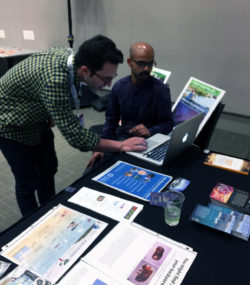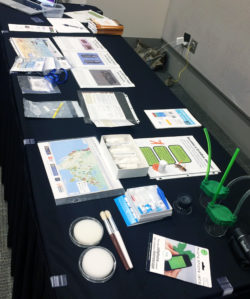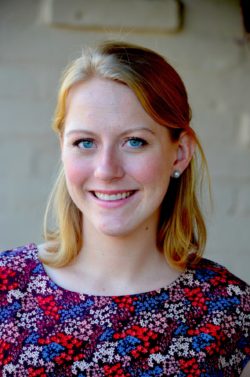Upbeat, collaborative, and focused: Educators at SXSWedu reflect on the value and future of citizen science in education
Posted on Categories Discover Magazine

Who really benefits from citizen science? How can citizen science support STEM education? How do we bring citizen science to new audiences? How can we leverage new technologies to expand student participation in citizen science projects?
Attendees explore tools together.
These were some of the questions we set out to discuss at the Citizen Science Meet-up at SXSWedu. SXSWedu is an annual conference that attracts thought-leaders from the worlds of education, technology, policy, and the media. This year, 7,000 participants from 38 countries—including bestselling authors, TED-talking professors, and quirky teachers—came together to discuss the future of teaching and learning. At SciStarter and the California Academy of Sciences, we believe that citizen science is an integral part of that future, so we joined forces to bring our ideas to the participants of SXSWedu.
We designed the Meet-up as an interactive experience with roundtable conversations and resource share-outs. In one corner of the room, participants explored a playground of citizen science projects and toolkits, including tinkering with arthropod observation tools, exploring the biodiversity app iNaturalist, and discovering diverse DIY projects featured on SciStarter. In another corner, at the Citizen Science Platter, the participants shared their insights about the role of citizen science in education today. Here’s what people were saying:
“We are upbeat and enthusiastic about the power of citizen science.” Citizen science is a powerful tool that can be used to tap into the natural curiosity of students and empower students to drive their own learning, both inside and outside the classroom. Moreover, citizen science has a low barrier to entry. “Everyone has a phone,” one attendee said, referring to the proliferation of elegant apps, such as iNaturalist and GLOBE Observer, that democratize participation in the scientific process.

SciStarter and the California Academy of Sciences display citizen science projects and tools at SXSWedu
“We need more collaborative work in the field.” We need best practices to guide collaborations between educators, scientists, and research on learning. For example, scientists can be more transparent about how the data collected by citizen scientists will be used. We also need to continue to develop ways citizen scientists can connect with each other to share experiences, learn from each other, and create a sense of community in citizen science. In addition to using Web apps, we might also ask citizen scientists to create portfolios of their work so that they can showcase their achievements and get feedback from students peers and other citizen scientists. For example, the new SciStarter dashboard is a digital portfolio for people to track, earn credit, and receive recognition for their contributions across projects. There is clearly an opportunity to expand this to serve the needs of classrooms.
“We need design that is more focused on who we are trying to reach.” As advocates for citizen science, we can make educators’ jobs easier by building more scaffolding around our designs. For example, as citizen science practitioners develop projects that are fit for schools, they might consider the limits of space at many schools. An added challenge is determining how citizen science can most effectively enhance STEM learning
The Meet-up created a renewed sense of the excitement about using citizen science as a learning and engagement tool for STEM education. There are many smart, creative, passionate people who are designing and evaluating citizen science experiences both in and out of the classroom. Our power comes from the communities we support, and we encourage program designers to not only collaborate across organizations, but also empower their audiences with additional resources. If you don’t know where to start, here are some ideas:
- The California Academy of Sciences Citizen Science Toolkit for Educators provides step by step instructions for integrating citizen science projects into classroom curricula or afterschool programming.
- The Cornell Lab of Ornithology BridSleuth program provides connections between the Next Generation Science Standards and Citizen Science.
- To get started on citizen science right away, check out SciStarter’s amazing repository of citizen science projects. Many projects have been rated, reviewed and aligned to standards by educators. You can search for projects that have teaching materials or search by appropriate grade-level. You and your students can set up personalized dashboard to help track involvement and interest in projects and help you discover personalized recommendations.
Together, we make the commitment to help connect citizen science more closely with educators, students, and, of course, anyone who wants to contribute to our understanding of the world. The future of citizen science is bright, and we welcome it with open arms.
For more information or to chat further please feel free to reach out!
 Katie Levedahl (KLevedahl@calacademy.org)
Katie Levedahl (KLevedahl@calacademy.org)
Katie drives the strategic design, implementation, and wide-scale expansion of science education resources that transform informal science learning. As the Director of Informal learning with the California Academy of Sciences her work includes expansion of offerings to serve thousands of people through the Academy’s youth leadership programs, the founding and scaling of the Science Action Club network, and a lead role with several regional STEM education networks.
 Catherine Hoffman (catherine@scistarter.com)
Catherine Hoffman (catherine@scistarter.com)
Catherine bring citizen science to new audiences through SciStarter. As the Managing Director of SciStarter she oversees strategic partnerships with formal and informal education groups, coordinates product development within SciStarter, and grows citizen science through festivals and events throughout the country.